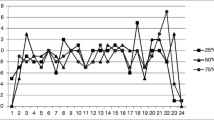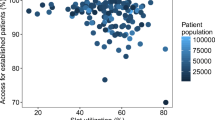Abstract
We propose a methodology to provide real-time assistance for outpatient scheduling involving multiple patient types. Schedulers are shown how each prospective placement in the appointment book would impact a day’s operational performance for patients and providers. Rooted in prior literature and analytical findings, the information provided to schedulers about vacant slots is based on the probabilities that the calling patient, the already-existing appointments, and the session-end time will be unduly delayed. The information is updated in real-time before and after every new booking; calculations are driven by each patient type’s historical consultation times and no-show data, and implemented via a simulation tool based on the underlying analytical methodology. Our findings lead to practical guidelines for dynamically constructing templates that provide allowances for different consultation durations, service time variability, no-show rates, and provider-driven performance targets for patient waiting and provider overtime. Extensions to healthcare batch scheduling applications such as radiology, surgery, or chemotherapy—where patient mixes may be known in advance—are suggested as future research opportunities since avoiding session overtime and procedures’ completion time delays involve similar considerations.




Similar content being viewed by others
References
Anderson RT, Camacho FT, Balkrishnan R (2007) Willing to wait?: the influence of patient wait time on satisfaction with primary care. BMC Health Serv Res 7:31
Berg BP, Denton BT, Erdogan SA, Rohleder T, Huschka T (2014) Optimal booking and scheduling in outpatient procedure centers. Comput Oper Res 50:24–37
Bleustein C, Rothschild DB, Valen A, Valatis E, Schweitzer L, Jones R (2014) Wait times, patient satisfaction scores, and the perception of care. Am J Manag Care 20:393–400
Boilson A, Craven F, Drummond A, Fitz-Simon N, O’Mahony D, Staines A et al (2007) INSIGHT ’07: Health and Social Services in Ireland—A Survey of Consumer Satisfaction. Health Service Executive. Naas, Ireland. https://www.hse.ie/eng/services/publications/Your_Service,_Your_Say_Consumer_Affairs/Reports/Insight_07.html. Accessed 16 Jan 2018
Camacho FT, Anderson R, Safrit A, Jones AS, Hoffmann P (2006) The relationship between patient’s perceived waiting time and office-based practice satisfaction. N C Med J 67:409–413
Cayirli T, Veral EA (2003) Outpatient scheduling in health care: a review of literature. Prod Oper Manag 12:519–549
Cayirli T, Veral EA, Rosen H (2006) Designing appointment scheduling systems for ambulatory care services. Healthcare Management Science 9:47–58
Cayirli T, Veral E, Rosen H (2008) Assessment of patient classification in appointment system design. Prod Oper Manag 17:338–353
Chakraborty S, Muthuraman K, Lawley M (2010) Sequential clinical scheduling with patient no-shows and general service time distributions. IIE Trans 42:354–366
Daggy J, Lawley M, Willis D, Thayer D, Suelzer C, DeLaurentis PC, Turkcan A, Chakraborty S, Sands L (2010) Using no-show modeling to improve clinic performance. Health Informatics J 16:246–259
Gans N, Koole G, Mandelbaum A (2003) Telephone call centers: tutorial, review, and research prospects. Manufacturing & Service Operations Management 5:79–141
Gupta D, Wang WY (2012) Patient appointments in ambulatory care. In: Hall R (ed) Chapter 4 Handbook of healthcare system scheduling. Springer, USA, pp 65–104
Harness J (2014) Audit of patient delay. Glenpark Medical Practice [blog]. http://www.glenpark.info/blog/audit-patient-delay. Accessed 31 August 2017
Herrler R, Heine C, Kluegl F (2002) Appointment scheduling among agents: a case study in designing suitable interaction protocols. AMCIS 2002 Proceedings 199:1456–1463
Huang XM (1994) Patient attitude towards waiting in an outpatient clinic and its applications. Health Serv Manag Res 7:2–8
Huang YL, Hancock WM, Herrin GD (2012) An alternative outpatient scheduling system: Improving the outpatient experience. IIE Transactions on Healthcare Systems Engineering 2:97–111
Huang Y, Verduzco S (2015) Appointment template redesign in a women’s health clinic using clinical constraints to improve service quality and efficiency. Applied Clinical Informatics 6 :271–287
Jansson B (1966) Choosing a good appointment system—a study of queues of the type (D, M, 1). Oper Res 14:292–312
Judice D, Rockwell P (1999) Patient perceptions of physicians’ time management behaviors: satisfaction and expectations. Int Electron J Health Educ 2:76–80
Kaandorp GC, Koole G (2007) Optimal outpatient appointment scheduling. Health Care Manag Sci 10:217–229
Klassen KJ, Rohleder TR (1996) Scheduling outpatient appointments in a dynamic environment. J Oper Manag 14:83–101
Klassen KJ, Yoogalingam R (2014) Strategies for appointment policy design with patient unpunctuality. Decis Sci 45:881–911
Kuiper A, Kemper B, Mandjes M (2015) A computational approach to optimized appointment scheduling. Queueing Systems 79:5–36
Lin J, Muthuraman K, Lawley M (2011) Optimal and approximate algorithms for sequential clinical scheduling with no-shows. IIE Transactions on Healthcare Systems Engineering 1:20–36
Liu N, Ziya S, Kulkarni VG (2010) Dynamic scheduling of outpatient appointments under patient no-shows and cancellations. Manufacturing & Service Operations Management 12:347– 364
Mak HY, Rong Y, Zhang J (2014) Sequencing appointments for service systems using inventory approximations. Manufacturing & Service Operations Management 16:251–262
Mak HY, Rong Y, Zhang J (2014) Appointment scheduling with limited distributional information. Manag Sci 61:316–334
Millhiser WP, Valenti BC (2012) Delay distributions in appointment systems with generally and non-identically distributed service times and no-shows. Available at SSRN: http://www.ssrn.com/abstract=2045074
Millhiser WP, Veral EA, Valenti BC (2012) Assessing appointment systems’ operational performance with policy targets. IIE Transactions on Healthcare Systems Engineering 2:274–289
Millhiser WP, Veral EA (2015) Designing appointment system templates with operational performance targets. IIE Transactions on Healthcare Systems Engineering 5:125–146
Muthuraman K, Lawley M (2008) A stochastic overbooking model for outpatient clinical scheduling with no-shows. IIE Trans 40(9):820–837
Oh HJ, Muriel A, Balasubramanian H, Atkinson K, Ptaszkiewicz T (2013) Guidelines for scheduling in primary care under different patient types and stochastic nurse and provider service times. IIE Transactions on Healthcare Systems Engineering 3:263– 279
Patrick J, Puterman ML, Queyranne M (2008) Dynamic multipriority patient scheduling for a diagnostic resource. Oper Res 56:1507–1525
Pérez E, Ntaimo L, Malavé CO, Bailey C, McCormack P (2013) Stochastic online appointment scheduling of multi-step sequential procedures in nuclear medicine. Health Care Manag Sci 16:281–299
Pinedo M, Wie SH (1986) Inequalities for stochastic flow shops and job shops. Applied Stochastic Models and Data Analysis 2:61–69
Pruhs K, Sgall J, Torng E (2004) Online scheduling. In: Leung JY-t (ed) Handbook of scheduling: algorithms, models, & performance analysis. Chapman & hall/CRC, Boca Raton
Qi J (2016) Mitigating delays and unfairness in appointment systems. Manag Sci 63:566–583
Ray KN, Chari AV, Engberg J, Bertolet M, Mehrotra A (2015) Opportunity costs of ambulatory medical care in the United States. Am J Manag Care 21:567–574
Ray KN, Chari AV, Engberg J, Bertolet M, Mehrotra A (2015) Disparities in time spent seeking medical care in the United States. JAMA Intern Med 175:1983–1986
Robinson LW, Chen RR (2011) Estimating the implied value of the customer’s waiting time. Manufacturing & Service Operations Management 13:53–57
Rohleder TR, Klassen KJ (2002) Rolling horizon appointment scheduling: a simulation study. Health Care Manag Sci 5:201–209
Santibáñez P, Aristizabal R, Puterman ML, Chow VS, Huang W, Kollmannsberger C, Nordin T, Runzer N, Tyldesley S (2012) Operations Research methods improve chemotherapy patient appointment scheduling. Jt Comm J Qual Patient Saf 38:541–553
Sgall J (1998) On-line scheduling. In: Online algorithms. Springer, Berlin, pp 196–231
Turkcan A, Zeng B, Muthuraman K, Lawley M (2011) Sequential clinical scheduling with service criteria. Eur J Oper Res 214:780–795
Walter SD (1973) A comparison of appointment schedules in a hospital radiology department. Br J Prev Soc Med 27:160–167
Wang PP (1999) Sequencing and scheduling N customers for a stochastic server. Eur J Oper Res 119:729–738
Westman G, Andersson SO, Ferry S, Fredriksson P (1987) Waiting room time in the assessment of an appointment system in primary care. Scand J Prim Health Care 5:35–40
Zacharias C, Pinedo M (2014) Appointment scheduling with no-shows and overbooking. Prod Oper Manag 23:788–801
Zeng B, Turkcan A, Lin J, Lawley M (2010) Clinic scheduling models with overbooking for patients with heterogeneous no-show probabilities. Ann Oper Res 178:121–144
Acknowledgements
The authors are grateful to Mr. Harshad Rokade, M.S., for DSS prototype development and coding support.
Author information
Authors and Affiliations
Corresponding author
Rights and permissions
About this article
Cite this article
Millhiser, W.P., Veral, E.A. A decision support system for real-time scheduling of multiple patient classes in outpatient services. Health Care Manag Sci 22, 180–195 (2019). https://doi.org/10.1007/s10729-018-9430-1
Received:
Accepted:
Published:
Issue Date:
DOI: https://doi.org/10.1007/s10729-018-9430-1




